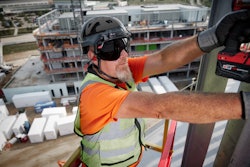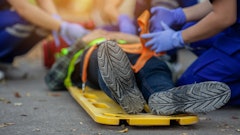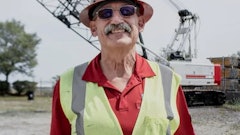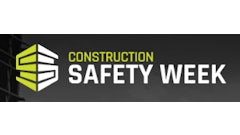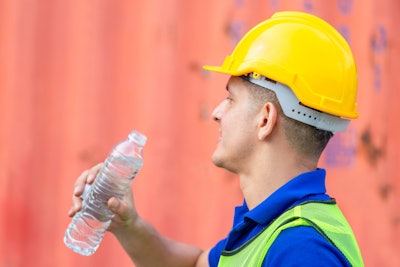
Summer 2025 is already breaking heat records across the country, and construction sites are feeling the pressure. With longer heatwaves and higher humidity, workers are facing more than just discomfort, they are facing serious health risks. Heat stress is no longer a seasonal concern. It's quickly becoming the biggest safety challenge on jobsites today.
Unlike slips or equipment mishaps, heat-related illnesses can sneak up fast. Fatigue, dizziness, and confusion are easy to miss until a worker collapses. These incidents are rising, especially among outdoor crews working long shifts without enough cool-down time. And the risks don’t just affect one trade or task, everyone is vulnerable.
Contractors can’t treat heat like just another hazard. It needs daily planning, better communication, and smarter scheduling. Without a clear approach, projects fall behind, and workers end up in danger. This article breaks down why heat stress is now the #1 threat on the jobsite and what crews need to do differently this summer.
Heat Stress: The Silent Jobsite Killer of Summer 2025
Heat stress is quietly becoming one of the biggest dangers on jobsites, especially during the summer months. With rising global temperatures, workers are being pushed to their physical limits, often without realizing the risk until it’s too late. In 2020 alone, over 231 million workers were exposed to heatwaves, a 66% jump from the year 2000. For construction workers, who often work under direct sunlight with heavy gear, the threat is even higher.
The numbers tell a worrying story. Heat stress is behind 23 million work-related injuries and more than 19,000 deaths each year. In the U.S., construction workers made up over one-third of all occupational heat-related deaths between 1992 and 2016. These are not just stats, they represent real people, families, and livelihoods changed forever by something preventable.
What’s worse is that this isn’t limited to one region. Injury rates from heat stress have climbed by 33.3% in the Americas and 16.4% in Europe and Central Asia. Countries across Africa, the Arab States, and Asia-Pacific are seeing even higher exposure levels, some reaching over 90%. Heat stress may be invisible, but its impact is loud and growing.
Why 2025's Rising Temperatures Are Creating New Risks for Construction Crews
Construction work has always been physically demanding, but 2025 is bringing new challenges. The intense heat is no longer a seasonal discomfort, it’s a daily safety threat. Just last summer, cities like Phoenix saw 113 straight days over 100°F, pushing outdoor workers into dangerous territory. These record-breaking temperatures aren’t a one-time event. Extreme heatwaves are becoming more frequent, putting added pressure on crews working in direct sun.
Heat doesn’t just make the day harder, it makes it more dangerous. For every 1°C increase in the humidex, the risk of traumatic injuries on job sites rises by 0.5%. That risk climbs even higher in cities, where urban heat islands can boost local temperatures by as much as 5°C (41°F). Add in high humidity, and workers may feel as if it’s 10°F hotter than the thermometer shows. These conditions not only raise the risk of heatstroke but also lead to fatigue, poor decision-making, and accidents.
This isn’t just a health issue, it’s a work issue. Experts warn that by 2030, heat stress may cut global working hours by 2.2%, equal to losing 80 million full-time jobs. For construction crews, that means more missed days, slower timelines, and higher risks all driven by the rising heat of 2025.
From Fatigue to Fatality: How Heat Stress Escalates on the Jobsite
Heat stress doesn’t start with collapse, it begins with tiredness, dizziness, or trouble focusing. These early symptoms are easy to ignore, especially on a busy jobsite. But for construction workers, the danger builds fast. One study found that 59% of construction workers reported heat-related symptoms during summer, even before temperatures peaked. When a worker is tired or dehydrated, mistakes happen, and small errors can quickly turn into major accidents.
As the day wears on, the risk keeps rising. Data shows that 43% of workers had core body temperatures over 100.4°F, with 4% crossing into severe danger zones above 101.3°F. Heat pushes the body past safe limits, especially when 63% of workers start their shifts already dehydrated. This makes it harder to cool down and easier for heat exhaustion or heat stroke to set in, conditions that can quickly become life-threatening.
The numbers are alarming. Though construction workers make up just 6% of the workforce, they account for 36% of all heat-related jobsite deaths in the U.S. They are also 13 times more likely to die from heat than workers in other industries. This shows how quickly heat stress can shift from a slow fatigue to a fatal event, especially if early signs go unnoticed or untreated.
Warning Signs Your Crew Might Be Ignoring! Until It’s Too Late
Warning Sign | What It Means |
| Excessive Sweating | The body is overheating and working hard to cool down, an early red flag. |
| Headaches or Dizziness | Blood flow to the brain may be affected. It can lead to confusion or collapse. |
| Muscle Cramps | Losing too much salt and water, a sign that dehydration is already setting in. |
| Hot, Dry Skin | A serious sign of heat stroke, the body has stopped sweating. |
| Nausea or Vomiting | Heat is starting to affect the stomach, can quickly lead to dangerous fatigue. |
| Confusion or Slurred Speech | The brain is not getting enough oxygen or cooling, medical help is needed fast. |
| Weak Pulse or Fainting | A late-stage symptom, the body is struggling to function and might shut down. |
Top 5 Mistakes Contractors Make in Managing Heat Exposure
Waiting Too Long to Act
Many contractors don’t take heat seriously until someone gets sick. By then, it’s too late. Early action during heat waves can save lives.
Not Giving Enough Breaks
Workers need time to cool down, especially during peak afternoon hours. Skipping or shortening breaks can quickly lead to heat exhaustion.
Forgetting About New or Returning Workers
New hires or those back from time off are more likely to get heat-related illnesses. They need lighter workloads for the first few days to let their bodies adjust.
Relying Only on Water
While water is important, it’s not the full answer. Without shade, rest, and smart scheduling, hydration alone won’t prevent heat stress.
No Real Plan in Place
Many job sites don’t have a written heat safety plan or training. If workers don’t know the signs of heat stress or what to do, small problems can turn into emergencies.
What the Latest Data Says About Heat Stress Injuries on Construction Sites
Global Impact: Around 23 million people are injured and almost 19,000 die each year around the world due to extreme heat at work.
Construction Worker Risk: In the U.S., construction workers made up 34% of all heat-related job deaths between 1992 and 2022, even though they are only about 6% of the total workforce.
Relative Risk: Construction workers in the U.S. are 13 times more likely to die from heat than workers in other jobs.
Outdoor Exposure: About 73% of construction workers in the U.S. mostly work outside, which makes them more at risk of heat stress.
Incidence of Dehydration and Heat Strain: A 2024 study found that 63% of construction workers started their shifts already dehydrated, and 43% got a body temperature higher than the safe limit of 38°C (100.4°F) while working in the summer.
Financial Cost: If a worker suffers from heat-related illness, it can cost the employer up to $80,000, including medical bills, compensation, and lost work time.
Project Delays: Hot weather can delay construction projects, raising the total cost by nearly 24% and extending the time needed by 26%.







